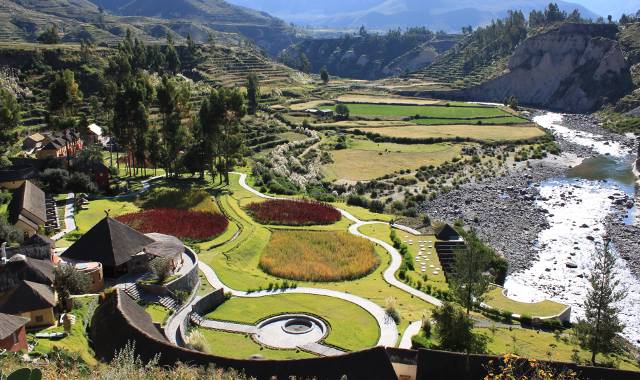Thursday 28 June Sillustani to Colca Lodge
We spent David's birthday on a long journey from Puno to Colca Lodge, near Yanque. Our first stop after an hour was to Sillustani. Wikipedia describes it as a:
pre-Incan cemetery on the shores of Lake Umayo near Puno in Peru. The tombs, which are built above ground in tower-like structures called chullpas, are the vestiges of the Qulla people, who are Aymara conquered by the Inca Empire in the 15th century..
Many of the chullpas at Sillustani show pre-Inca characteristics that
were later redressed with Inca stone blocks. Most mummy bundles indicate
burial in a fetal position... The only openings to the buildings face east, where it was
believed the Sun was reborn by Mother Earth each day.
Only important people were placed in chullpas. Ordinary people were buried. The fetal position is chosen because of their belief in reincarnation.
A garment featuring gold leaf was found buried near a chullpa. The theory is that this was done to ensure that tomb robbers would be disappointed and go away.
 |
| Compare the small pre-Inca chullpa on the left with the larger Inca chullpa above |
 |
| Western face of Inca-era chullpa |
 |
| Chullpa with ramp, needed to add mummified bodies |
 |
| Eastern edge with entrance |
 |
| Woodpecker - Andean flicker |
 |
| Ancient farming strips warmed by adjacent water |
|
|
|

No shortage of water in the high Andes.
 |
| View of volcanic ash deposits from our lunchstop cafe |
The government controls vicuna and does not allow anyone to own them. They have never been domesticated. However, their wool is the finest in the world, less than 9 microns, and is harvested every 1 or 2 years. Locals make a circle around the herd to do this. All the wool is sent to Italy for processing.
 |
| Happy to see these wild vicuna |
|
|
 |
| Someone's farm |
|
|
People rely on herding alpaca, llama, sheep or cows from Switzerland at altitudes of 3400m up to 4000m. They are mostly vegetarian, we're told, living to 80-90 years. They sell wool, meat (especially alpaca which is great to eat, no fat), yoghurt and cheese. The small cows produce 10L of milk a day.
 |
| An active volcano |
 |
| 2 hours later, we came to Colca River near our hotel |
 |
| Road construction slowed progress to our hotel, Colca Lodge (image taken from their website) |
|
|
|
 |
| Colca Lodge has its own thermal pools and spa. At 5pm after 10 hours travelling, we were too tired to take advantage of them. Also I was unwell with a persistent head cold. |
 |
| Next-door llama farm |
That evening we had a good dinner in the hotel restaurant with our travelling companions. One lady kindly ordered a surprise one-serve birthday cake, the staff dimmed the lights and we all sang Happy Birthday.
Friday 29 June Colca Canyon and Condors
 |
| In the rainy season it is possible to raft down the Colca River to the Pacific Ocean |
We were en route to Condor Cross when our party saw condors from the bus. To our delight, there were no crowds and we had close views of at least 3 adult and 7 juvenile birds. Only 30-40 condors live in Colca Canyon but they can reliably be seen in the mornings before 10am. Wing span is around 3.25m. Males have brown eyes and a crest; females red eyes. Juveniles have brown feathers and eyes. They live 50-80 years but have only one baby each year or second year. Farmers are allowed to use poison baits against predators on their baby animals.
The Canyon may be the deepest in the world at 4160m, though this can be disputed.
 |
| 2 adult condors |
 |
| Juvenile condor |
 |
| Six juveniles; top two have crests |
 |
| 1 female, 2 male juveniles |
We moved on to the crowded Condor Cross area and saw a few adult condors.
 |
| Viewpoint across canyon |
|
Much spectacular scenery after leaving the canyon:
At the small village of Maca locals with baby alpacas hoped to make money from photos. Most people did. A man appeared with a baby bottle of milk for this little one after the photo.
We visited Iglesia Santa Ana which incorporated Andean aspects into Christianity, such as dressing some saints in local clothing. Mary is usually seen as Pachamama, the Earth goddess, and placed centrally where Europeans would put Jesus. Here there was a novel twist with St Ann the central figure.
We arrived at Arequipa around 4:30.

































































